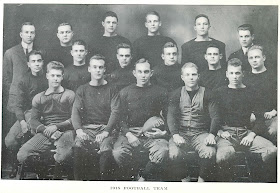 Before their arrival in Hanover to meet in person and begin their Dartmouth careers, many members of the class of 2015 undoubtedly spent the past few months getting to know each other on Facebook. A hundred years ago, another group of '15s was the first class to get acquainted with the help of the Green Book, also known as the Freshman Book. As the foreword to the 1915 Green Book states:
Before their arrival in Hanover to meet in person and begin their Dartmouth careers, many members of the class of 2015 undoubtedly spent the past few months getting to know each other on Facebook. A hundred years ago, another group of '15s was the first class to get acquainted with the help of the Green Book, also known as the Freshman Book. As the foreword to the 1915 Green Book states:The continual growth of Dartmouth College has made it harder and harder each year to learn the records and abilities of the entering class. This Year Book is published with the hope that it will satisfy a want for information in much the same way as does the Yale Blue Book and the Harvard Red Book. If it succeeds in giving its readers a good knowledge of the composition of 1915, we shall feel fully repaid.
Unlike later volumes of the Green Book, the first one didn't include photos of every member of the class. Only the class officers, the 1915 football team, and Prof. Craven Laycock, Assistant Dean (and later of nose-rubbing-for-luck fame), are shown. The book provides each student's full name, nickname, fraternity, hometown, high school attended and activities in which they participated, and dorm address at Dartmouth. Particularly interesting is the section entitled "1915 Statistics," which includes data compiled from information provided by 353 members of the class. From this we learn that the class of 1915 came from 192 preparatory and high schools, of which "only 11 have a representation numbering five or more." The school that provided the most entering freshmen that year? Phillips Exeter (twelve). The book also provides information about the entering students' parents; for example, how many were college graduates (76 fathers -- of which 19 were Dartmouth men -- and 16 mothers), the schools from which they graduated, and fathers' professions. Data on the religious preference of class members is also provided. The 1915 book appears to have been published in the spring of 1912, as it also includes summaries of the class performances in track, football, basketball, and hockey.
In 2009 the College decided to stop publishing the Green Book (or 'shmenu, as it was sometimes called), so the class of 2012, who will graduate this spring, is the last class to have one.
Get to know Jimmie, Ingy, Hutch, Skinny, Edge, Jiggs, Mudge, and generations of Dartmouth students who followed them by consulting the Dartmouth Green Books in the reading room of Rauner Library.


No comments:
Post a Comment